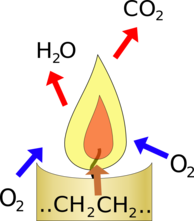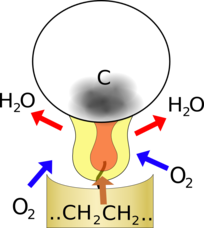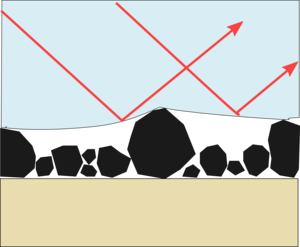Ingredients
| A candle | Something opaque but not flammable like a mug or a spoon. |
Instructions
Light your candle
Hold the mug in the yellow part of the flame and build up a good layer of soot.
Be careful the mug could be hot!
Put the sooty part of the mug into a deep basin of water. Does it look the same?
Result
You should find that the soot suddenly becomes shiny and when you take it out again it will still be dry.
Explanation
The soot repels water very strongly (is hydrophobic) which means that a layer of air is trapped between the soot and the water and light reflects from the surface of the water, and the soot looks shiny.
The layer of air keeps the soot dry, so it isn't wet when you take the mug out again.
Why does the candle produce soot?
大多数蜡烛是由碳氢化合物组成的,consisting of molecules made up of carbon and hydrogen. When the candle burns oxygen reacts with the hydrogen to form water and with the carbon to form carbon-dioxide. The hydrogen tends to react slightly quicker so there is a region of the flame with small particles of carbon. When you put something cold in this region these will condense on the surface forming black soot.
 |
 |
| A candle burns hydrocarbons made up of hydrogen and carbon with oxygen to form water and carbon-dioxide | The hydrogen buns more quickly than the carbon, so there is an area of the candle which is carbon-rich. So if you put something cold in the way the carbon will condense as soot. |
Why is the soot so hydrophobic?
If you look at this soot on a microscopic scale it is extremely rough. The carbon particles themselves are quite dark but the roughness makes it even darker as any light that reflects from one particle will often hit another and get absorbed.
 |
 |
| Soot is made up of lots of different sizes of particles. | Soot is dark because the particles are dark, and because the surfaces are so rough, most of the light that is reflected will hit another particle and be absorbed. |
When you put it into water the soot particles are quite hydrophobic, so the water will only wet the very highest bits of the soot. The surface tension supports the water in between these peaks and you get a layer of air between the water and the soot.
The surface of the water reflects light very well due to an effect called total internal reflection (for more look at the
water fibre opticsexperiment), just like when you look up from underwater in a swimming pool and the surface looks like a mirror.
 |
 |
| The soot particles repel water slightly and because it is so rough, surface tension will hold the water away from the surface. This traps a layer of air between the soot and the water. | The light istotally internally reflectedat small angles, behaving like a mirror so the surface looks shiny. |
- PreviousAcoustic Levitation
- NextFlubber








Comments
Right on
Right on
This was so helpful!!!!!!!!!!
This was so helpful!!!!!!!!!!!!
Add a comment